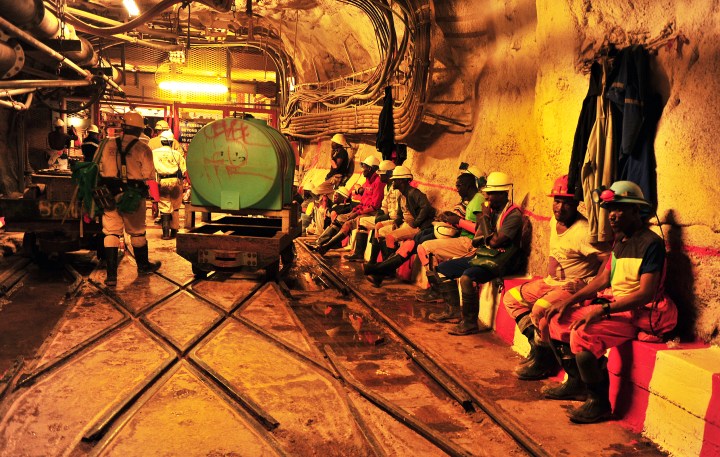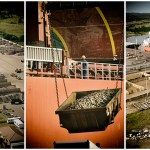MINING
Shimmer of hope — what’s behind another gold rush in South Africa

A decline in labour unrest and safer mines have made exposure to the precious metal a less-risky proposition. Plus, a leap in share prices, brought on in part by a weaker rand, has boosted local producers.
Harmony Gold is one of the top-performing gold companies, defying those who have written off the gold sector in South Africa, where it gets most of its production.
Of South Africa’s major historical gold producers, Gold Fields is about the only other company left standing here – albeit with only one asset – and its share price has also been shooting the lights out as the precious metal’s price has raced to record highs.
Sibanye-Stillwater is another big gold producer, but its exposure to platinum – which has been hammered by collapsing prices – dilutes the value of its comparison.
Phenomenal growth
At the time of writing on 18 April, Harmony’s share price is up about 47% in the year to date and has gained 570% over the past five years. Gold Fields’ is 25% and more than 500% higher over the same periods.
The price/earnings (P/E) ratio forecasts for this year for both companies are also stellar compared with peers.
Harmony’s is 11.09 and Gold Fields’ is 14.0, according to Nasdaq data. These are relatively low, suggesting the current share value is low relative to earnings.
The contrast with the world’s two top gold producers, which have no assets in South Africa – US-based Newmont and Canadian-based Barrick Gold – is stark. Their share prices are down about 5% and 6% year-to-date, whereas over the past five years they were respectively 22% and 28% higher.
Newmont’s forecast P/E ratio for this year is 18.90, and Barrick’s is 18.10.
This has unfolded against the backdrop of a red-hot gold price, which has hit record highs above $2,400 an ounce in recent days – a rise of more than 16% since January.
One factor is the weaker rand. Gold’s rand price has shot up 20% so far this year, and that will flow to the bottom line of Harmony and Gold Fields’ mechanised South Deep operation – though the latter accounts for only 14% of Gold Fields’ global production.
Another potential factor is the shareholding profiles of the companies. Harmony’s is 40% South African and 40% American, and Gold Fields’ is 44% South African. Newmont’s and Barrick’s are skewed towards North America.
South African investors understand and are comfortable with gold equities – this has deep historical roots. There are North American fund and asset managers invested in mining, including gold equities, but overall there is much less interest in these sectors there.
“Since 2000 you had a massive run in equities, and then there was the global financial crisis, and then they spent their way out of it, incurred more and more debt, and markets have fully recovered,” Bruce Williamson, a mining analyst at Integral Asset Management, told Daily Maverick.

“So, making money in equities and bonds has been so easy for so long. And I think people look and say we are not interested in gold equities, we don’t understand it.”
On that front, it’s interesting to note that AngloGold Ashanti – which has exited South Africa as a producer – has seen its share price rise close to 30% in the year to date and its 2024 P/E forecast is a promising 13.16. And its shareholding remains close to half South African.
One industry source, who asked not to be named, said that South African asset and fund managers in an election year were looking for good hedge stocks and saw value in gold and gold equities.
Market signal
Sibanye CEO Neal Froneman noted that the global disconnect between the gold and share price of producers was a market signal.
“The markets are normally efficient and why I think there is upside in the gold price, normally when there is a disconnect with the equity price it’s a sign that the markets think it’s overdone. So they’ll not allow current gold prices to reflect in share prices,” he told Daily Maverick.
The gold price has also largely been lifted by central bank purchases – not those that put their clients’ investments into equities – against the backdrop of rising geopolitical tensions and a gradual move away from the dollar as a reserve currency among emerging markets.
Two key elements of risk have also been removed from the South African gold and wider mining scene – trends local investors will be well aware of.
One has been a dramatic decline in labour unrest. Harmony recently signed a historic five-year wage deal with five unions, and Gold Fields has solid labour relations at South Deep.
The other is a massive improvement in mine safety at a time when investors are averse to mines with a high death toll.
Read more in Daily Maverick: Mining sector seeks next breakthrough in reducing falls of ground fatalities
Mponeng, the world’s deepest, reaching almost 4km below the surface, which Harmony acquired from AngloGold Ashanti, has also proved to be a cash spinner. This goes against the grain of investor jitters about deep-level South African mining.
South African gold producers, especially Harmony, also initially lagged the spurt in the gold price, and have only caught up recently in the view of some analysts.
“We believe South Africa gold stocks have now largely caught up with the gold price… We would thus still be sellers of gold equities at these levels, as we believe there could be a sharp downside if gold prices correct from these levels,” Nedbank analyst Arnold van Graan said in a recent note.
But for Harmony – and to a lesser extent Gold Fields – the rand gold price and other factors have clearly boosted their share prices and outlook. Exposure to South Africa’s gold sector, which is seen to be fraught with risk, is currently no bad thing. DM
This story first appeared in our weekly Daily Maverick 168 newspaper, which is available countrywide for R35.




















Good investigative journalism.
Hear hear!